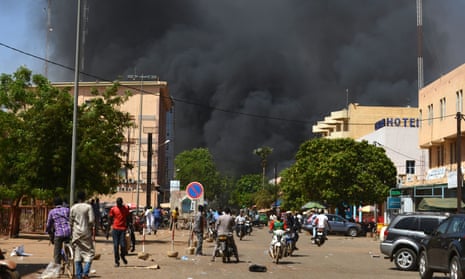Cameroon, a central African state of 24 million people on the Gulf of Guinea, is rarely in the news – which is surprising, given the awful things happening there. In a warring world full of conflict, the country’s troubles barely rate a mention. That’s short-sighted. As Yemen shows, today’s local difficulties have a habit of becoming tomorrow’s international crises.
Long-running tensions between Cameroon’s French and English-speaking communities came to a head last week with the arrest of at least 350 members of the main opposition party, whose leader has been jailed since January. Human Rights Watch accused security forces of using “excessive and indiscriminate force”.
Political repression may be the least of Cameroon’s worries. According to a new Norwegian Refugee Council report, Cameroon is the world’s most neglected displacement crisis. Since 2016, conflict between government forces and non-state armed groups has forced 450,000 people from their homes.
According to the report, “780,000 children are out of school. Hundreds of villages have been burned down, tens of thousands of people are hiding in the bush with no humanitarian support, and attacks are taking place every day.” Both the government and separatists are accused of “horrific human rights violations”.
Though the specifics vary, Cameroon does not suffer in isolation. Its instability reflects that of its neighbours – Nigeria, Chad and the Central African Republic – and the wider Sahel region. Across this vast area, home to numerous other under-reported conflicts, the developed world’s present-day neglect is sowing a poisonous future harvest.
In Nigeria, the notorious Boko Haram insurgency has been pegged back. But the rise of less-known Isis affiliates, such as so-called Islamic State West Africa, and regional jihadist groups is a cause of growing concern, says the US-based Council on Foreign Relations.
About 2.4 million people in the Lake Chad basin are displaced. “Although the Nigerian military has regained control in parts of the north-east, civilians in Nigeria, Cameroon, Chad and Niger continue to be affected by grave violations of human rights, widespread sexual and gender-based violence, forced recruitment and suicide bombings,” the UN’s refugee agency says.
Investigations by the New Humanitarian project suggest the Sahel emergency is intensifying rapidly. “A surge in violence in recent months in Mali, Burkina Faso and Niger has left more than 440,000 people displaced and 5,000 dead as militants – some with links to al-Qaida and Isis – extend their grip across the region,” it reported in May.
The ramifications of this advance are dire. “As they gain ground, the jihadists are stoking conflicts between different ethnic groups … putting the region’s entire social fabric into question. Cycles of inter-communal violence are now claiming more lives and uprooting more people than direct jihadist attacks,” New Humanitarian says.
Neglected or forgotten conflicts are by no means confined to sub-Saharan Africa. Nor are political, ethnic or religious tensions the only factors. Conflicts are often rooted in the failure of authoritarian, incompetent or corrupt governments to protect their citizens, as in Sudan. Struggling communities may fear state security forces more than they fear local militias, as in Kashmir.
Yet the inattention of wealthy countries, coupled with the damaging impact of their economic and cultural behaviour, are powerful factors, too. Interventionism, and escalation of local conflicts by the co-opting of proxy forces, are on the rise, as seen in Libya where rival states back opposing sides.
At the same time, external diplomatic mediation and third-party peace efforts are declining even as the total number of conflicts rises, according to Oslo’s Peace Research Institute. The western world has long fixated, for example, on the Israel-Palestine peace process. By contrast, no comparable commitment is seen in Somalia, ravaged by decades of conflict.
Aggravating this neglect are inadequate, under-fire western foreign aid and assistance budgets. UN humanitarian appeals are routinely under-funded. Aid can become a political football, as happened recently in Venezuela. Meanwhile, environmental degradation linked to the climate crisis is increasing poverty and inequality, helping to drive conflict.
Climate change, specifically drought, played a key role in sparking the Darfur genocide in the early 2000s, where farmers were pitted against herders. It is a factor now in Iraq, Egypt and other areas of the Middle East where competition for ever scarcer water supplies is intensifying. It is a factor, too, in a resurgence of preventable diseases, as in the Democratic Republic of Congo.
The link to conflict is evident. “Environmental degradation is starting to reverberate and affect economic growth,” a Brookings Institution study of sustainability declared last month: “Disasters triggered by weather and climate-related hazards were responsible for thousands of deaths and $320bn in losses in 2017 … Water stress linked to climate change is already contributing to migration, which in turn can lead to conflict.”
According to the Armed Conflict Location and Event Data Project, political violence and protest surged worldwide last year. “These trends showed few signs of stopping in 2019,” it says. In its list of looming flashpoints, relatively neglected conflicts in the Sahel, South Sudan, the southern Philippines and Myanmar feature alongside better-reported wars in Syria and Afghanistan.
The International Crisis Group casts its net even wider. Rising tensions, from multiple causes, in Benin, Togo, Sri Lanka, Honduras, Nicaragua, Kosovo and Iran all need to be carefully watched, too, it says in its June CrisisWatch report.
In one sense, it’s an impossible task. In another sense, greater focus on conflict prevention and resolution in everyone’s interest. The scale of the challenge merely underscores an inescapable 21st-century reality: rather than question multilateralist approaches, the international community needs to work together more closely than ever if, collectively, it hopes to survive.

